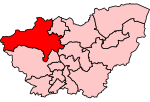Silkstone
AC with 0 elementsCivil parishes in South YorkshireGeography of the Metropolitan Borough of BarnsleyUse British English from July 2016Vague or ambiguous time from September 2018 ... and 1 more
Villages in South Yorkshire

Silkstone is a village and civil parish in the Metropolitan Borough of Barnsley in South Yorkshire, England. It is situated in the foothills of the Pennines, between the towns of Barnsley and Penistone, and includes the village of Silkstone Common. At the 2001 census it had a population of 2,954, increasing to 3,153 at the 2011 Census.Silkstone Parish is twinned with Saint-Florent-des-Bois in France.
Excerpt from the Wikipedia article Silkstone (License: CC BY-SA 3.0, Authors, Images).Silkstone
High Street,
Geographical coordinates (GPS) Address Nearby Places Show on map
Geographical coordinates (GPS)
| Latitude | Longitude |
|---|---|
| N 53.5489 ° | E -1.5634 ° |
Address
Silkstone Pharmacy
High Street
S75 4JJ , Silkstone
England, United Kingdom
Open on Google Maps








